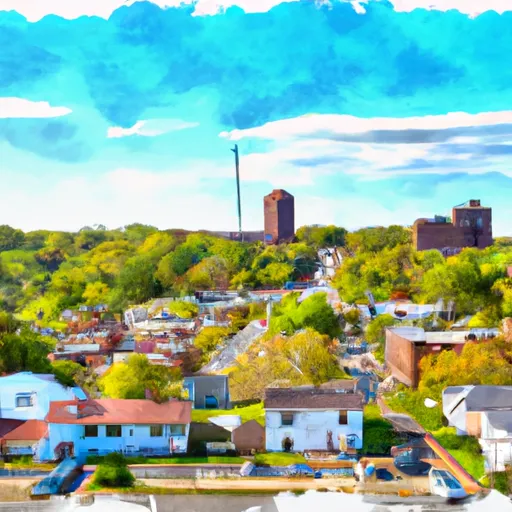-
 Snoflo Premium
Snoflo Premium
Get unlimited access to all our content
With no Ad interruptions! - Start Your Free Trial Login with existing account
Uniontown
Eden Index
Climate
8.3
•
Recreation
2.8
•
Community
3.5
•
Safeguard
5.2/10

Uniontown, Maryland is a charming town located in Carroll County, offering a pleasant climate and a variety of outdoor recreation opportunities. The town experiences a humid subtropical climate, characterized by hot summers and mild winters. Summers are generally warm and humid, with temperatures averaging in the high 80s Fahrenheit. Winters are cooler, with average temperatures in the low 30s Fahrenheit.
Uniontown is surrounded by picturesque landscapes and boasts various hydrology constituents, including small streams and ponds. The area is well-known for the Union Mills Reservoir, a popular spot for fishing and boating enthusiasts. The reservoir is home to a diverse range of fish species, making it a favorite destination for anglers.
Outdoor recreation opportunities in Uniontown are abundant. The town is surrounded by lush forests, offering excellent hiking and nature trails. Nearby parks, such as the Piney Run Park and Bear Branch Nature Center, provide opportunities for picnicking, bird watching, and wildlife observation. Additionally, Uniontown is in proximity to Liberty Reservoir, which offers opportunities for boating, fishing, and hiking along its scenic trails.
Overall, Uniontown, Maryland provides a favorable climate, abundant hydrology constituents, and a variety of outdoor recreation opportunities, making it an ideal destination for nature lovers and outdoor enthusiasts.
What is the Eden Index?
The Snoflo Eden Index serves as a comprehensive rating system for regions, evaluating their desirability through a holistic assessment of climate health, outdoor recreation opportunities, and natural disaster risk, acknowledging the profound impact of these factors on livability and well-being.
Climate Health Indicator (CHI): 8.3
Uniontown receives approximately
1115mm of rain per year,
with humidity levels near 86%
and air temperatures averaging around
12°C.
Uniontown has a plant hardyness factor of
6, meaning
plants and agriculture in this region thrive during a short period during spring and early summer. Most
plants will die off during the colder winter months.
By considering the ideal temperature range, reliable water supplies, clean air, and stable seasonal rain or snowpacks, the Climate Health Indicator (CHI) underscores the significance of a healthy climate as the foundation for quality living.
A healthy climate is paramount for ensuring a high quality of life and livability in a region, fostering both physical well-being and environmental harmony. This can be characterized by ideal temperatures, reliable access to water supplies, clean air, and consistent seasonal rain or snowpacks.
Weather Forecast
Streamflow Conditions
Potomac
Area Rivers
Potomac
Snowpack Depths
Potomac
Reservoir Storage Capacity
Potomac
Groundwater Levels
Recreational Opportunity Index (ROI): 2.8
The Recreational Opportunity Index (ROI) recognizes the value of outdoor recreational options, such as parks, hiking trails, camping sites, and fishing spots, while acknowledging that climate plays a pivotal role in ensuring the comfort and consistency of these experiences.
Access to outdoor recreational opportunities, encompassing activities such as parks, hiking, camping, and fishing, is crucial for overall well-being, and the climate plays a pivotal role in enabling and enhancing these experiences, ensuring that individuals can engage in nature-based activities comfortably and consistently.
Camping Areas
| Campground | Campsites | Reservations | Toilets | Showers | Elevation |
|---|---|---|---|---|---|
| Andrews AFB Military | None | 269 ft | |||
| Louise F. Cosca Regional Park | 23 | 223 ft | |||
| Fort Belvoir Travel and RV Camp | 52 | 132 ft | |||
| Pohick Bay Regional Park | 150 | 126 ft | |||
| Greenbelt Park | 175 | 121 ft |
Nearby Ski Areas
Catastrophe Safeguard Index (CSI):
The Catastrophe Safeguard Index (CSI) recognizes that natural disaster risk, encompassing floods, fires, hurricanes, and tornadoes, can drastically affect safety and the overall appeal of an area.
The level of natural disaster risk in a region significantly affects safety and the overall livability, with climate change amplifying these risks by potentially increasing the frequency and intensity of events like floods, fires, hurricanes, and tornadoes, thereby posing substantial challenges to community resilience and well-being.
Community Resilience Indicator (CRI): 3.5
The Community Resilience Indicator (CRI) recognizes that education, healthcare, and socioeconomics are crucial to the well-being of a region. The CRI acknowledges the profound impact of these elements on residents' overall quality of life. By evaluating educational resources, healthcare accessibility, and economic inclusivity, the index captures the essential aspects that contribute to a thriving community, fostering resident satisfaction, equity, and social cohesion.

